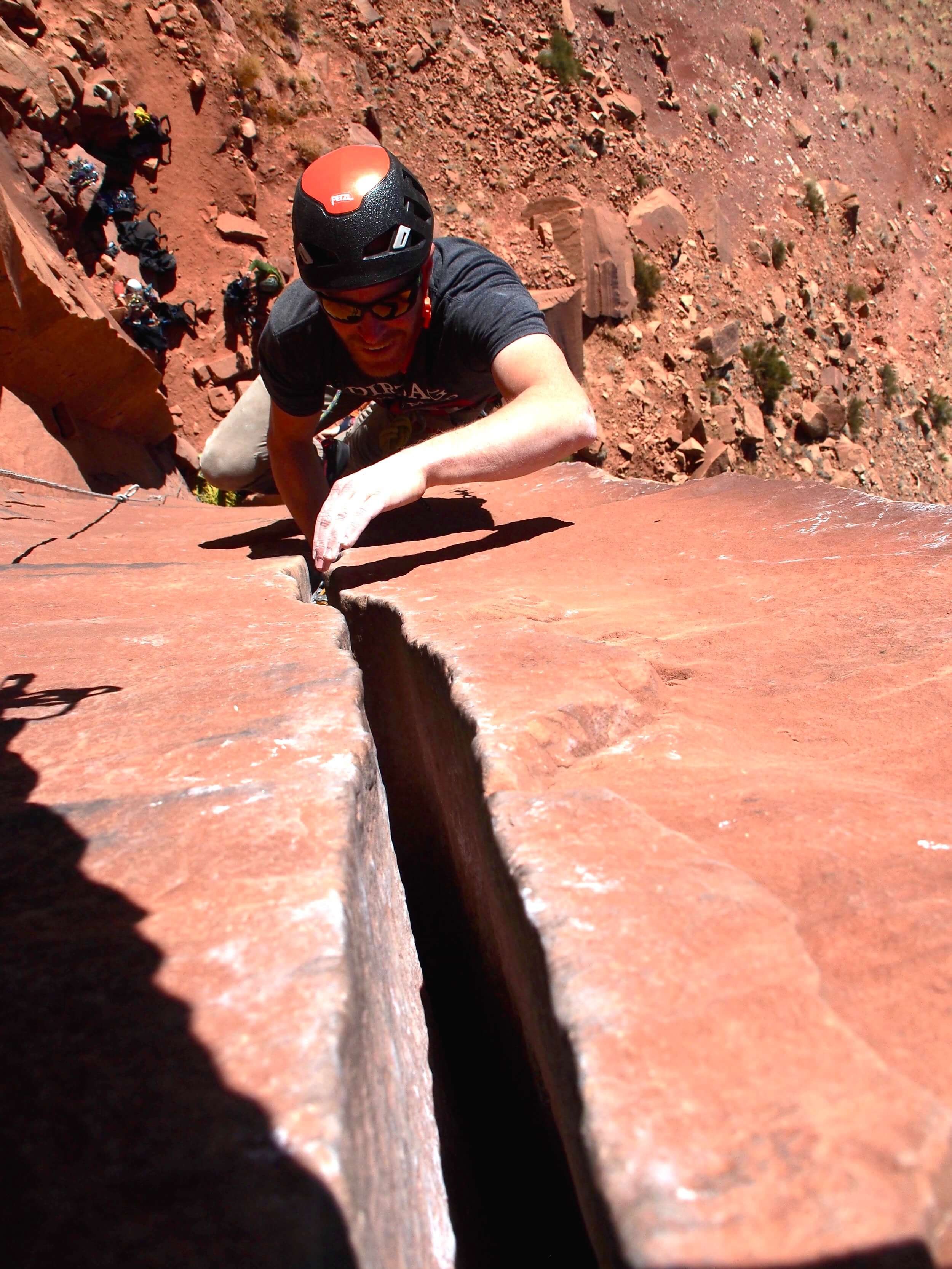
Rock Climbing on the Iconic Castleton Tower
Castle Valley
This is it! These are the desert towers everyone is talking about as must-do Moab rock climbing routes. Castle Valley is defined by the imposing Castleton Tower and multiple other sandstone towers dominating the skyline and 360-degree views looking towards the La Sal mountains, the Fisher Towers and down the Colorado River. All of the desert tower routes in Castle Valley require previous rock climbing experience, but with routes from 5.9 and upward we’ll help you choose a route appropriate for your climbing abilities, not to mention your perfect sized crack. Here are some of our favorite routes:
Castleton Tower
North Chimney (5.9-, III)
Kor-Ingalls (5.9+, III)
North Face (5.11-, III)
ThE Rectory
Fine Jade (5.11-, III)
Ministry (5.11, III)
The Priest
Honeymoon Chimney (5.11-, III)
PArriot Mesa
Super Natural (5.10, III)
Learn How to Crack Climb Efficiently
The rock climbing on Castleton Tower and the other surrounding desert towers demands good crack climbing technique. Skyward Mountaineering guides are also passionate instructors with a breadth of experience coaching climbers to hone their movement skills and peek in their climbing abilities. Castleton Tower’s proximity to world class single pitch crack climbing in Moab, Utah makes it a great place to spend a few days focusing on the nuances of crack climbing. With your specific goals and previous experience in mind, we’ll set up a custom itinerary pairing movement focused instruction with classic multipitch adventures on the desert towers.
Interested in more rock climbing in the Moab area? Check these trips out:
Moab Rock Climbing
Ancient Art
Crack Climbing Clinic
The Moab desert is a fantastic winter escape with the lower elevation and warmer temps. The best seasons for rock climbing are in the spring and fall when temps are most comfortable, it’s possible to chase the sun or shade depending on current conditions.
The easiest route in Castle Valley is the North Chimney, a steep 5.9 multipitch crack climb. Climbers must be at least 5.9 crack climbers and have previous multipitch experience. The approach hike is approximately 1.5 hours uphill. There are plenty of nearby areas in Moab for more novice rock climbers where we can develop the skills necessary for these routes.
If flying in, most people will prefer to arrive at Grand Junction Regional or Salt Lake City International Airport. A personal or rental vehicle will be necessary as climbing areas are spread out and remote.
There are plentiful hotels in downtown Moab, conveniently located in walking distance to restaurants. There are also multiple camping options at BLM campgrounds, these can be reserved online at recreation.gov
Climbers are responsible for providing their own personal clothing and equipment. See recommended gear list below:
-
Underwear: Should be comfortable, synthetic fibers wick moisture away from the body
Hiking socks: Lightweight warmth/cushion
Sun hat
Lightweight t-shirt: Merino wool or synthetic fibers will wick sweat away and keep you cooler and more comfortable during hot temps
Midweight fleece jacket: An integrated hood adds warmth and weather protection
Wind jacket: Should have an integrated hood, stretch fabric is often more durable
Hard shell jacket: Lightweight protection for afternoon thunderstorms
Lightweight insulated jacket: Down is lighter and more compressible
Climbing pants or leggings: Lightweight and stretchy
Shorts: Optional, for warmer temps
-
Climbing backpack: Approximately 30+ liters
On-route pack: Approximately 15 liters, optional for longer routes. It is also possible to carry a 25-ish liter pack to the base of the route and then also use it on the route instead of the two pack system
Approach shoes: Should have sticky rubber outsole for security while scrambling on the approach and/or descent, though lightweight hiking shoes are an acceptable substitution
Rock climbing shoes: Comfortable for all day wear
Chalk bag w/ chalk
Belay gloves: Full fingered recommended
Crack gloves: Optional, manufactured tape gloves are more comfortable and provide great base coverage for the best protection while hand jamming
Climbing helmet: Must be UIAA certified
Harness: Must have a belay loop and at least two gear loops
Tubular belay device with round bar stock locking carabiner
Assisted braking device: Your guide can provide a lightweight device to securely belay the leader, but if have a preferred device such as a GriGri, you may bring that
48 inch (120cm) sewn nylon sling. A Personal Anchor System (PAS) may be used instead
2-3 Locking carabiners: Lightweight, screwgate is easier to operate than a triple-action carabiner
1-2 Non locking carabiners
-
Sunglasses: Dimmable recommended, CAT 3 lenses w/ athletic fit
Small tube of sunscreen and SPF chap stick
First aid kit: Small, should include any personal medications
Fully charged phone
Headlamp with fully charged batteries
1-2 liters of water: A soft water bottle is more comfortable in a pack but care needs to be taken to not puncture it
High energy lunch and snacks: A healthy mix of fats, sugar, and protein for a full day of the on-the-go (leftover pizza or sandwiches are a great midday pick-me-up)

Includes:
1 day of guided rock climbing on Castleton Tower or other Moab desert tower with an AMGA certified Rock Guide
Group climbing equipment (ropes, rock protection and anchor material)
Does Not Include:
Additional expenses associated with a change in the itinerary
Transportation
Lodging
Meals
Guide gratuity





